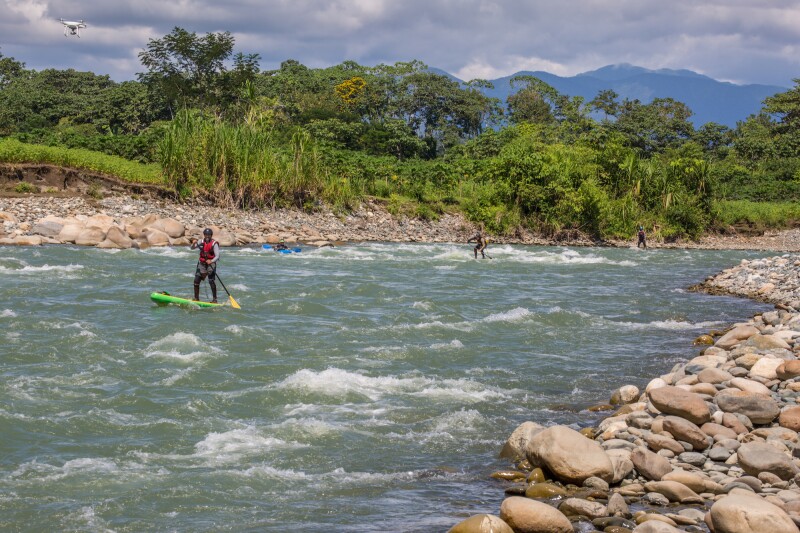The air is hot and heavy in the Peruvian Amazon, and when I take a deep breath it tastes of plants, decay, and sweat. Hot sub-tropical sun falls on my back as I trail my toes through the chocolate-brown water. Sweat drips down my face, and an ambitious sand fly lands on my neck, defying the layers of DEET I’ve applied in the hours since dawn. I slap it away and watch the water ahead as we seek out the best path for the SUP boarders trailing us.
I’m in the middle of the Amazon, floating down one of its several tributaries on this once-in-a-lifetime experience thanks to Pepe Lopez. The founder of Cuzco-based Apumayo Expediciones, Lopez is our fearless leader on this expedition. On the surface, our mission is simple: to explore rivers near and in Peru’s Manu National Park to determine if it would be feasible to create a stand-up paddle board (SUP) adventure tourism program to showcase the area and the river.
We began our journey in Cuzco, crisscrossing the Peruvian Andes before dropping down into the jungle and heading out on the rivers. It’s now midway through the float, and we’ve progressed from the cooler, rapid-filled waters of the mid-level jungle rivers, Queros and Tono, to the muddy behemoth of the Alto (Upper) Madre de Dios, which eventually leads into the inner depths of the Amazon Basin.

Evenings on the river
Photo by Jess McGlothlin
Each night we stop at a lodge, sorting gear, cooking, and resting a few hours under a vital layer of mosquito netting. For the first two nights, we were based out of Villa Carmen, a biological research station run by the Amazon Conservation Association. But as we move down the river system, we’ve left those comfy beds and that hearty local food behind. Now we spend our nights cooking dinner by headlamp at more rustic encampments.
Life is remarkably comfortable in such a wild setting, thanks in large part to Lopez’s planning and the team’s willingness to just “get it done,” whether we’re dodging down a class IV rapid or lugging heavy coolers up a steep riverside ledge to make camp. We’ve adjusted quickly to true “jungle time.” Mornings are early; dawn breaks around 5:30 a.m., but we’re usually up before the sun, prepping breakfast over the camp stove and dumping a mix of freshly filtered water and coffee grounds into a large bowl to make surprisingly legitimate camp coffee. The sun sets 12 hours later. Thus far we’ve done well, and usually, camp is set up and the rafts unloaded before darkness falls. Darkness in the jungle, I’ve quickly learned, is as forbidding as any I’ve experienced in my travels.
The sheer amount of life in the rain forest is staggering; it’s one of the world’s most biodiverse places. But it’s not without risks: The environment itself tests those who dare enter its boundaries. I combat persistent onslaughts of sand flies and mosquitoes with long sleeves and pants—and biblical amounts of DEET. We are constantly on the lookout for snakes and spiders, careful to shake out our boots every morning and watch where we step (and squat!) in the rain forest. We spotted jaguar tracks along the river at one stop, a potent reminder that larger threats roam the thick jungle as well. It almost feels like the jungle is constantly trying to eat you.
The river itself is not much different. Falling off your paddle board simply becomes a fact of life on an expedition like this, and I’ve spent plenty of time wondering just how far I could lean out of the raft with my camera before gravity took over and I went for a swim. Now, as I look around at the muddying waters that signal the beginning of the Alto Madre de Dios, a new volley of concerns hits my brain. Caimans and piranhas are known to inhabit the jungle waters. I ask if I—or anyone, really—should be concerned, and the reply comes with a shrug. Apparently, caimans are “pretty chill,” and flesh-eating fish are only a problem if I hit a rock in the river and start bleeding.

Photo by Jess McGlothlin
Common sense and basic preventative measures have successfully kept us safe throughout the journey. We take basic precautions—if someone has to go out at night, they are required to bring a “battle buddy.” We regularly check each other’s insect bites for signs of leishmaniasis, a nasty parasitic disease spread by sand flies. At night, we duck underneath mosquito netting, exhausted and sleeping hard beneath the fine mesh.
There may not be much room for error in the jungle, but there’s plenty of room for the unexpected. Along the way we find all sorts of random treasures waiting to be explored: a beaten-up, old Russian Antonov plane being slowly digested by the jungle near Villa Carmen but still largely intact, a resort-perfect hot spring just a short hike inland, which we quickly turn into a makeshift and much-needed bathtub.
Beyond the fascinating finds, there’s a real culture and life to be experienced along the Amazon River. Locals tell us interesting tales, mostly concerning uncontacted tribes in the vicinity. One notable story about a 10-meter anaconda at a particular river junction was shared while I stood thigh-deep in the water at that very confluence. I promptly shot for dry land. (Legendary anacondas aside, we came in contact with only one snake during the entire expedition.)
Eventually, the time comes to leave the jungle behind. I grinned as we powered back upriver, back to where we started. Despite the hardships, I’ve come away with a modest total of seven insect bites over the course of the nearly two-week trip. What’s more, our expedition was deemed a success: They will develop a SUP voyage down the Amazon for tourists. I look forward to seeing the tourism program in action, introducing more people to this wild and mysterious place, and led—inimitably—by Pepe Lopez.











